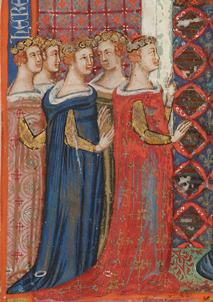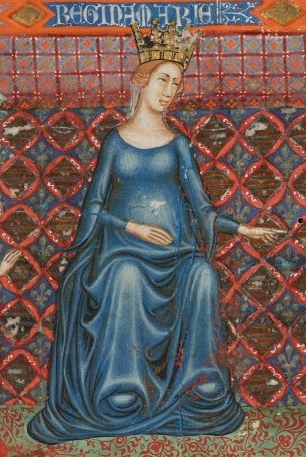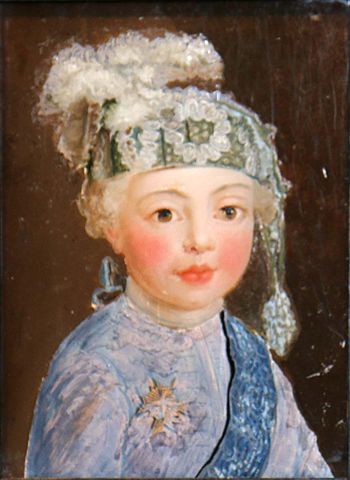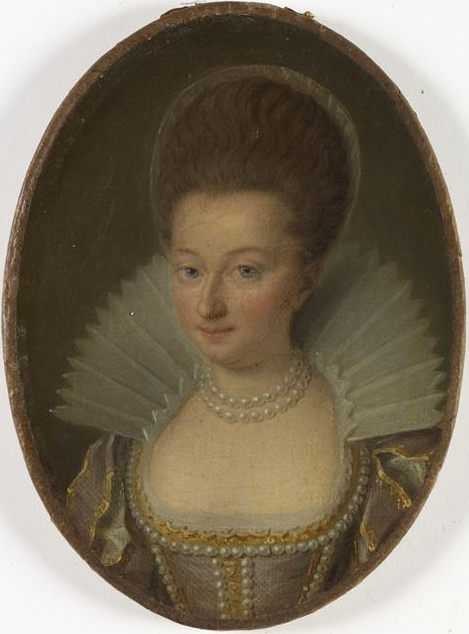August 27, 1669 birth of Anne Marie D'Orleans, Queen of Sardinia.
She was also the maternal grandmother of Louis XV.
Anne was the daughter of Philippe I, Duke of Orleans. Through her father she was the granddaughter of Louis XIII and Anne of Austria. Her mother was Philippe's first wife Princess Henrietta of England. Though her mother she was the granddaughter of Charles I and Henrietta Maria of England. She was the last of her mother's eight pregnancies (5 ended in miscarriage or stillbirth). At the time of her birth her only living sibling was her parents' first child Marie Louise who was seven. Her brother Philippe Charles had died at 2 in 1666. Maria Louise would go on to marry Charles II of Spain but had no children.
Her mother died in June 1670 when she was only 10 months old. Her father remarried to 19 year old Elizabeth Charlotte, Madame Palatine in 1671. Elizabeth was a loving stepmother and very close to both girls. Elizabeth bore three of her own children to Philippe. Her first son Alexandre died at 3, but like her predecessor Elizabeth bore 2 children to reach adulthood. Her second son Philippe would succeed his father as Duke of Orleans and marry Françoise Marie de Bourbon, Légitimée de France, with whom he had eight children. Their daughter Elisabeth Charlotte would marry Leopold, Duke of Lorraine and have 15 children.
Her Uncle Louis XIV wished to strengthen France's ties to the Italian states. He arranged his niece's marriage to her third cousin Victor Amadeus II of Savoy. Her Uncle was a close ally of Victor's mother Marie Jeanne. The bride was 14 and her groom was 17.
Their marriage was held by proxy in Versailles April 10, 1684. Her cousin the Duke of Maine stood proxy for the groom. Louis gave her a dowry of 900,000 livres. She met her husband at Chambéry on May 6, having been accompanied by the wife of François Marie, Prince of Lillebonne on the journey. Francois was a cousin of her father. They were married by the archbishop at the castle there and 2 days later made the trip to Turin.
The marriage in part was arranged by Jeanne Baptiste d'Albert de Luynes who was a mistress of her husband until 1700. The woman bore Victor two children. But the marriage seemed well enough, producing 6 children (3 who reached adulthood). When her husband fell ill with smallpox she nursed him herself.
She became quite close to her mother in law who was still a power at court. This bond between his wife and mother was not viewed well by her husband. When her husband severed ties with France in 1690, she accompanied her mother in law when she left Turin in protest (she was still a huge supporter of the French alliance), and took their children with her. When her brother and the Spanish attacked Turin, her and her sons had to flee to Genoa.
Her husband became King of Sicily in 1713 when peace was finally achieved. Her stepmother wrote of her pride in knowing Anne would be a queen. her husband had not planned to take her to Sicily but he feared his mother's power over her, if he left her behind as regent. So she was crowned next to her husband in Sicily.
The couple both suffered great depression on the death of their eldest son in 1715 and his mother stepped in as regent during the time. In 1720 her husband was forced to give up Sicily and accept Sardinia instead. But he got to keep the title of King, making her the first queen consort of Sardinia.
Though she had use of other homes, her main home was her villa outside of Turin.
https://en.wikipedia.org/wiki/Palazzina_di_caccia_of_Stupinigi
She died at the villa from heart failure in 1728 on the day before her 59th birthday. She was buried at the Basilica of Superga where all her children but two daughters would be buried.
Victor would remarry Anna Canalis di Cumiana. He abdicated after his marriage became public, in favor of his son. When he tried to reclaim his throne, his son had him arrested and his wife temporarily housed in a home for former prostitutes (though she was allowed to rejoin him). He died in 1732 and wished to be buried at the same Basilica as Anne but his son refused to allow it and he was buried at Convent of San Giuseppe di Carignano. His wife was sent to a convent where she died.
Anne Marie and Victor's children:
-Marie Adelaide: was sent to France for her education and married at 12 to the Duke of Burgundy. Louis's father and her mother were cousins (his father was the son of Louis XIV). The couple died from the measles during the life time of his grandfather, so never were more Dauphin. They were the parents of Louis XV (2 older sons died young). Unlike her parents' marriage, theirs was one of love, and when she died from measles, her husband caught them from nursing her, and died six days later.
-Maria Anna: died age three
-Maria Luisa Gabriela: married Philip V of Spain. Bore her husband four sons, 2 of whom reached adulthood. Both would serve as king, Louis I and Ferdinand VI. The couple had no grandchildren, and her son Ferdinand was succeeded by a half brother Charles from Philip's second marriage.
-Victor Amadeus, Prince of Piedmont: died at age 15. Originally buried in the cathedral but later at the basilica his mother is buried in (built by his father). He died from smallpox.
-Charles Emmanuel: succeeded his father as King of Sardinia during his life time. He married three times, but all three wives died before their 30th birthday. Countess Palatine Anne Christine of Sulzbach died shortly after giving birth to her only child at 19, a son Vittorio who died in infancy. Princess Polyxena of Hesse-Rheinfels-Rotenburg died at 29 and bore him 6 children, four who made it to adulthood including his successor Victor Amadeus III. Princess Elisabeth Thérèse of Lorraine died just short of 30 and bore 3 children but only her youngest son made it to adulthood.
-Emanuele Philibert of Savoy: died after less then 3 weeks of life.
Anne and her line inherited the Jacobite claim to the throne following the death of Bonnie Prince Charlie and his brother.






 No doubt for Maria Dorothea, being married into a catholic monarchy but not converting would not have been an easy adjustment.
No doubt for Maria Dorothea, being married into a catholic monarchy but not converting would not have been an easy adjustment. 